Attached files
| file | filename |
|---|---|
| 8-K - FORM 8-K - HARSCO CORP | w82382e8vk.htm |
Exhibit 99.1
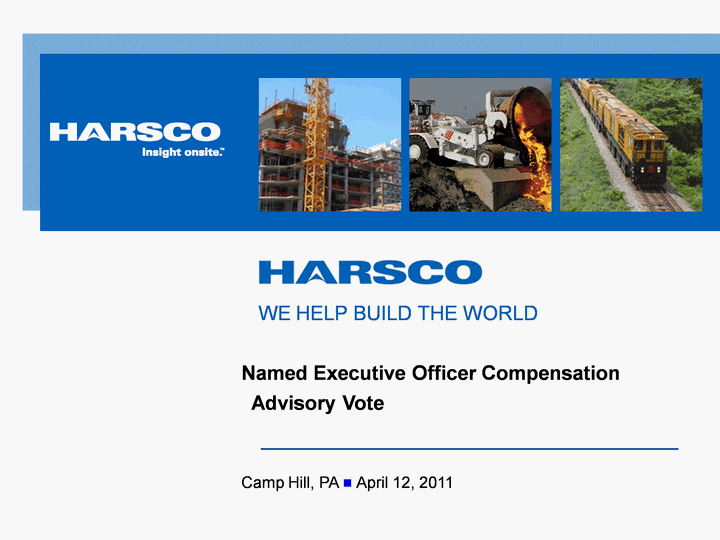
| WE HELP BUILD THE WORLD Camp Hill, PA ? April 12, 2011 Named Executive Officer Compensation Advisory Vote |
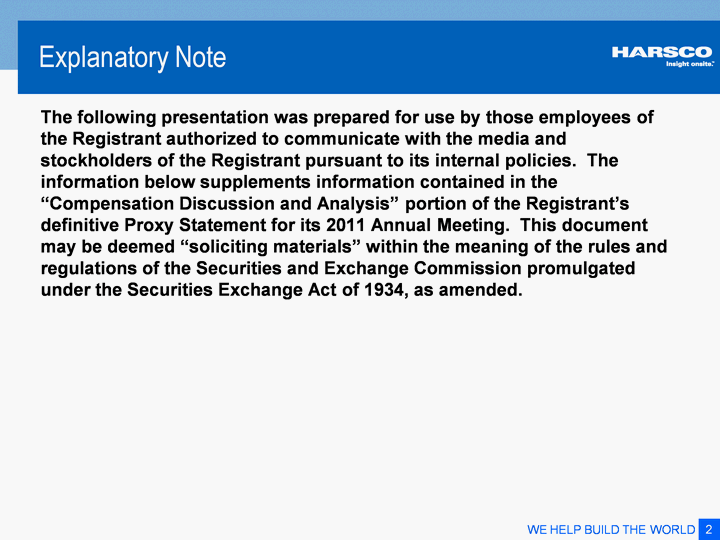
| Explanatory Note The following presentation was prepared for use by those employees of the Registrant authorized to communicate with the media and stockholders of the Registrant pursuant to its internal policies. The information below supplements information contained in the "Compensation Discussion and Analysis" portion of the Registrant's definitive Proxy Statement for its 2011 Annual Meeting. This document may be deemed "soliciting materials" within the meaning of the rules and regulations of the Securities and Exchange Commission promulgated under the Securities Exchange Act of 1934, as amended. |
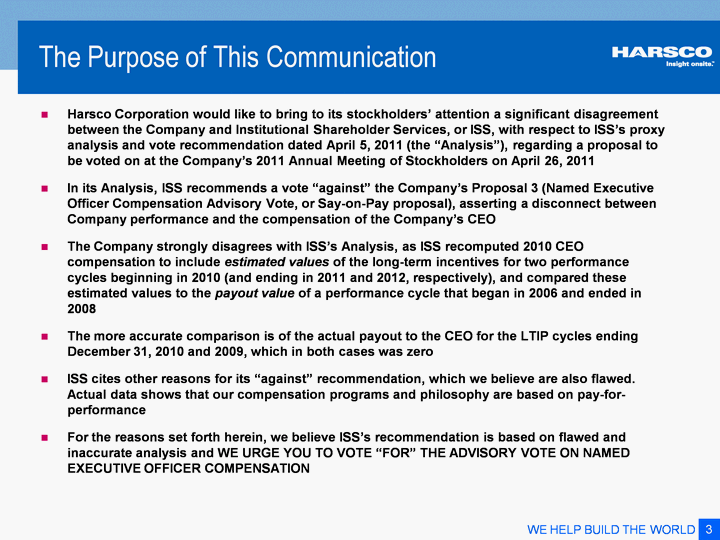
| The Purpose of This Communication Harsco Corporation would like to bring to its stockholders' attention a significant disagreement between the Company and Institutional Shareholder Services, or ISS, with respect to ISS's proxy analysis and vote recommendation dated April 5, 2011 (the "Analysis"), regarding a proposal to be voted on at the Company's 2011 Annual Meeting of Stockholders on April 26, 2011 In its Analysis, ISS recommends a vote "against" the Company's Proposal 3 (Named Executive Officer Compensation Advisory Vote, or Say-on-Pay proposal), asserting a disconnect between Company performance and the compensation of the Company's CEO The Company strongly disagrees with ISS's Analysis, as ISS recomputed 2010 CEO compensation to include estimated values of the long-term incentives for two performance cycles beginning in 2010 (and ending in 2011 and 2012, respectively), and compared these estimated values to the payout value of a performance cycle that began in 2006 and ended in 2008 The more accurate comparison is of the actual payout to the CEO for the LTIP cycles ending December 31, 2010 and 2009, which in both cases was zero ISS cites other reasons for its "against" recommendation, which we believe are also flawed. Actual data shows that our compensation programs and philosophy are based on pay-for- performance For the reasons set forth herein, we believe ISS's recommendation is based on flawed and inaccurate analysis and we urge you to vote "FOR" the advisory vote on named executive officer compensation |
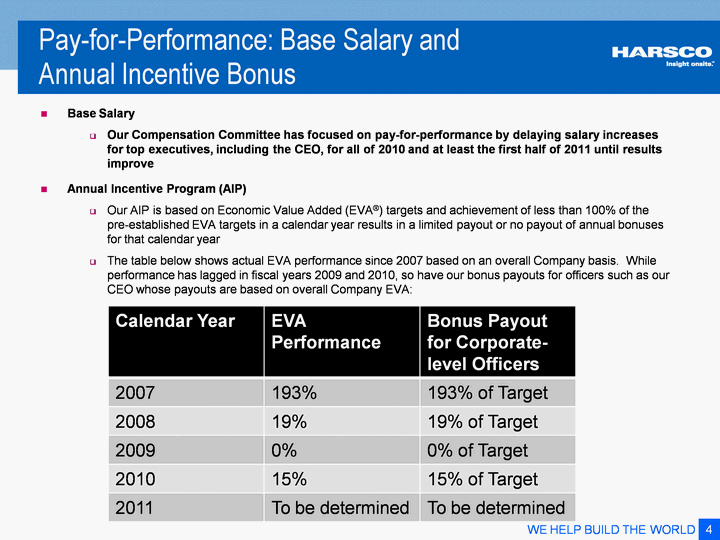
| Pay-for-Performance: Base Salary and Annual Incentive Bonus Base Salary Our Compensation Committee has focused on pay-for-performance by delaying salary increases for top executives, including the CEO, for all of 2010 and at least the first half of 2011 until results improve Annual Incentive Program (AIP) Our AIP is based on Economic Value Added (EVA(r)) targets and achievement of less than 100% of the pre-established EVA targets in a calendar year results in a limited payout or no payout of annual bonuses for that calendar year The table below shows actual EVA performance since 2007 based on an overall Company basis. While performance has lagged in fiscal years 2009 and 2010, so have our bonus payouts for officers such as our CEO whose payouts are based on overall Company EVA: Calendar Year EVA Performance Bonus Payout for Corporate-level Officers 2007 193% 193% of Target 2008 19% 19% of Target 2009 0% 0% of Target 2010 15% 15% of Target 2011 To be determined To be determined |
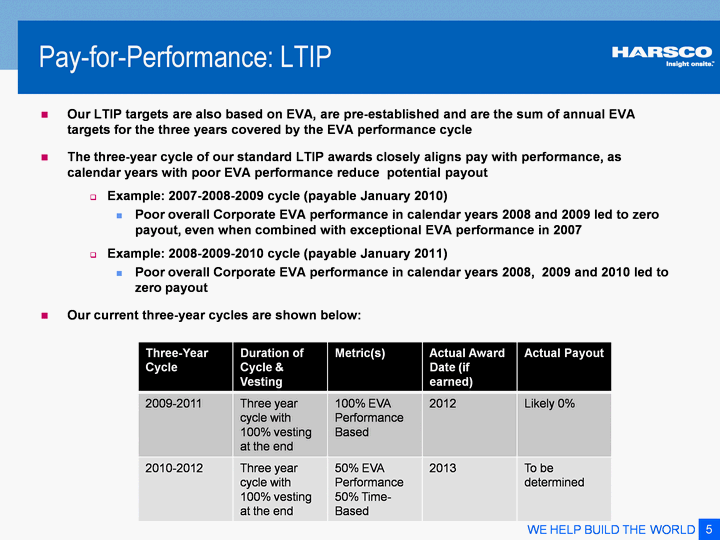
| Pay-for-Performance: LTIP Our LTIP targets are also based on EVA, are pre-established and are the sum of annual EVA targets for the three years covered by the EVA performance cycle The three-year cycle of our standard LTIP awards closely aligns pay with performance, as calendar years with poor EVA performance reduce potential payout Example: 2007-2008-2009 cycle (payable January 2010) Poor overall Corporate EVA performance in calendar years 2008 and 2009 led to zero payout, even when combined with exceptional EVA performance in 2007 Example: 2008-2009-2010 cycle (payable January 2011) Poor overall Corporate EVA performance in calendar years 2008, 2009 and 2010 led to zero payout Our current three-year cycles are shown below: Three-Year Cycle Duration of Cycle & Vesting Metric(s) Actual Award Date (if earned) Actual Payout 2009-2011 Three year cycle with 100% vesting at the end 100% EVA Performance Based 2012 Likely 0% 2010-2012 Three year cycle with 100% vesting at the end 50% EVA Performance50% Time-Based 2013 To be determined |
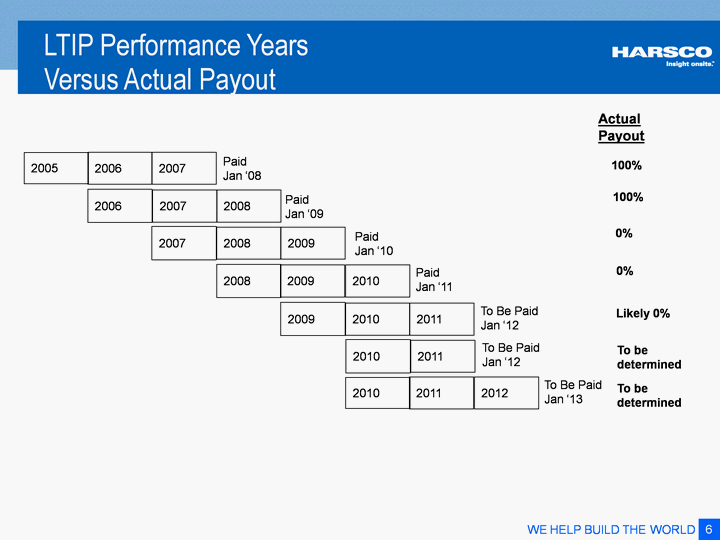
| 2005 Paid Jan '08 LTIP Performance Years Versus Actual Payout 2006 2007 2006 2007 2008 2007 2008 2009 2008 2009 2010 2009 2010 2011 2010 2011 2010 2011 2012 Paid Jan '09 Paid Jan '10 Paid Jan '11 To Be Paid Jan '13 To Be Paid Jan '12 To Be Paid Jan '12 Actual Payout 100% 0% 100% 0% Likely 0% To be determined To be determined |

| Retention: The Special Two-Year LTIP Grant The EVA performance targets for a special 2010-2011 LTIP award were established based on advice of Stern Stewart, one of our compensation consultants The Compensation Committee and the Board granted this award due to their concerns with regard to retention of key executives and senior level employees The Board determined that, without the two-year program, we would be at a competitive employment disadvantage compared to other companies, since at the time of the two-year grant (1) no equity compensation was paid in 2010, (2) no equity compensation was likely to be paid in 2011 (and none was actually paid) and (3) it was likely that no equity compensation would be paid for the 2009-2011 three year cycle This LTIP award is 100% performance-based (EVA), represents less shares than would be awarded under a typical three-year plan, and payout will only occur in 2012 if the EVA performance targets for the two-year period are achieved Two-Year Cycle Duration of Cycle & Vesting Metric(s) Actual Award Date (if earned) 2010-2011 2-year special one-time grant with 100% vesting at the end 100% EVA Performance 2012 |

| Other Proxy Advisory Services Recommend a "FOR" vote on NEO Compensation Advisory Firm Recommendation on Proposal 3 Comments Glass Lewis Yes Noted that the Company aligned executive compensation with performance during 2010 Egan-Jones Yes Notes strong alignment between our pay-for-performance culture and the long-term interests of our stockholders and the need to attract and retain experienced, highly qualified executives ISS No A flawed analysis led to a negative recommendation by ISS on Proposal 3 |
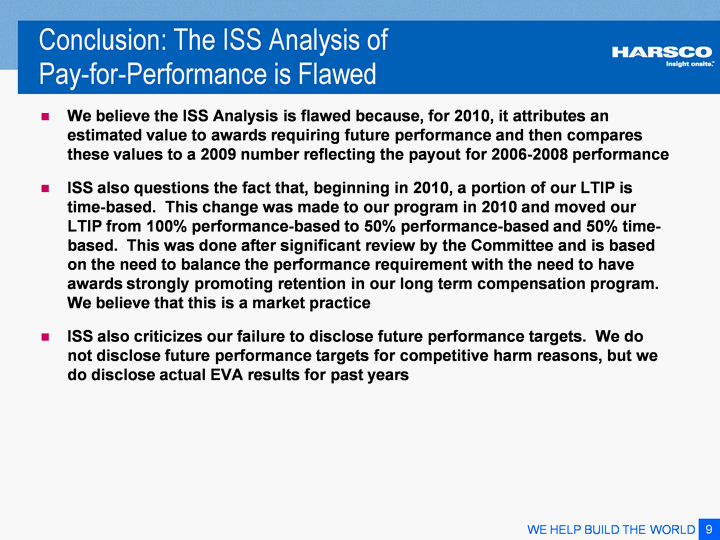
| Conclusion: The ISS Analysis of Pay-for-Performance is Flawed We believe the ISS Analysis is flawed because, for 2010, it attributes an estimated value to awards requiring future performance and then compares these values to a 2009 number reflecting the payout for 2006-2008 performance ISS also questions the fact that, beginning in 2010, a portion of our LTIP is time-based. This change was made to our program in 2010 and moved our LTIP from 100% performance-based to 50% performance-based and 50% time- based. This was done after significant review by the Committee and is based on the need to balance the performance requirement with the need to have awards strongly promoting retention in our long term compensation program. We believe that this is a market practice ISS also criticizes our failure to disclose future performance targets. We do not disclose future performance targets for competitive harm reasons, but we do disclose actual EVA results for past years |
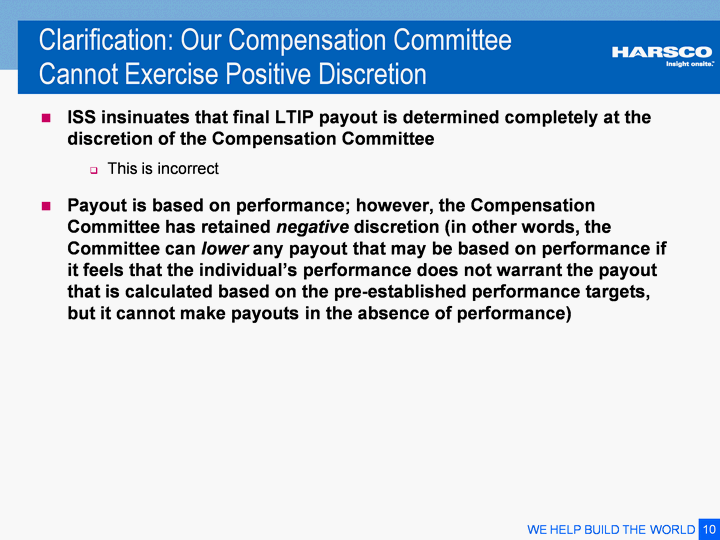
| Clarification: Our Compensation Committee Cannot Exercise Positive Discretion ISS insinuates that final LTIP payout is determined completely at the discretion of the Compensation Committee This is incorrect Payout is based on performance; however, the Compensation Committee has retained negative discretion (in other words, the Committee can lower any payout that may be based on performance if it feels that the individual's performance does not warrant the payout that is calculated based on the pre-established performance targets, but it cannot make payouts in the absence of performance) |

| We Urge You to Vote "FOR" The Advisory Vote on Named Executive Officer Compensation ISS's Analysis is Flawed: It is clear that our CEO's compensation over the past several years has been closely aligned with performance. The levels of our CEO's compensation opportunities are 33% below ISS's own estimate of the median peer group CEO compensation Our Compensation Committee is actively involved in managing pay- for-performance and has restricted compensation while supporting the steps management has taken to improve the performance of the Company Harsco has taken bold steps to improve its performance: New operational leadership has been put in place in all of our Divisions The Company has undertaken significant restructuring programs in both our Infrastructure and Metals divisions over the past 18 months Retaining our key executives is key to our executing upon our plans to improve our performance |
